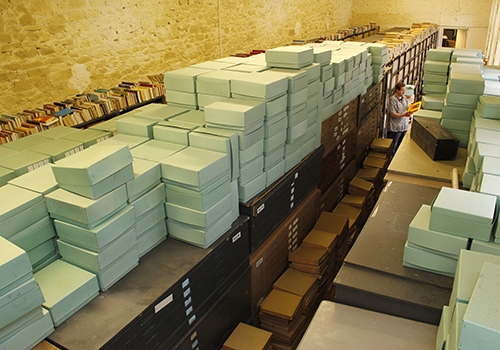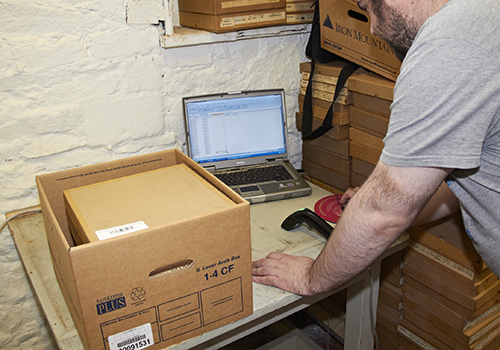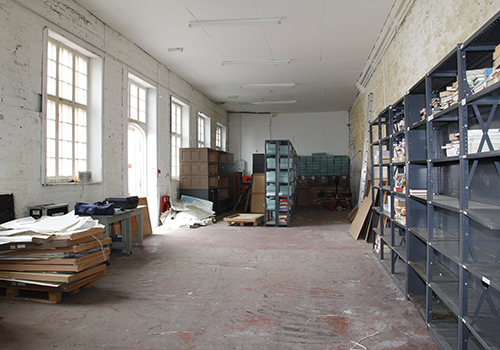Saving the DOS Collection
|
The DOS store at the British Empire and Commonwealth Museum (BECM), seen on the first day of the removal project.
This storage area contained the DOS 1st Print Library, along with associated finding aids, print laydowns, maps and files. A further two rooms held more print boxes, files and other documents. |
 |
|
Over 17,000 boxes of prints were housed at BECM. While vertically-stored boxes are easier to retrieve from shelving, prints housed in semi-full boxes are liable to slump and curl inside their box.
The first task for the NCAP team was to move sufficient print boxes into a separate area in order to create a working space. Benches were then laid out so that boxes could be sorted, barcoded and photographed in a logical flow before being packed for transit. |
 |
|
The key reason for photographing the print boxes was to rapidly capture the unique metadata recorded on each box, detailing the contents, that when tabulated into a database would allow specific sorties to be retrieved from remote storage. Barcode recognition software was used to semi-automatically re-name each of the 17,425 image files created.
A further benefit of recording each box photographically was that during the tabulation of the metadata it was possible to make a conservation assessment of each box. |
 |
|
Each of the 17,425 boxes of aerial prints was photographed alongside a barcode label that was subsequently applied to the storage box housing the respective print boxes.
The size of the DOS collection dictated that it was from the outset destined to be stored remotely from the NCAP office. To facilitate this, a manifest of all barcoded boxes and pallets was compiled, to enable NCAP to recall specific boxes as and when they are required. |
 |
|
After storage in a damp former stable-block, many DOS files and photographs suffered from mould damage and require paper conservation.
The files contained in cabinets like this one detail the aerial photographic work undertaken for DOS around the world and are a key part of the story of surveying in individual Commonwealth countries. |
 |
|
As work progressed, empty shelving was dismantled, allowing the team to build pallets of boxes in the storage area. In this image, several pallets have been prepared for uplift, while team members check over a stack of finding aids.
The contents of over 40 map chests were examined and sorted, with cover traces and associated mapping stacked and secured on pallets.These are the means of locating aerial coverage of specific geographical locations and will be central to any future cataloguing project. |
 |
|
The storage area at BECM on completion of the removal project. All pallets of print boxes and finding aids have been removed for onward transport in a fleet of articulated lorries.
Within days of the removal of the collection, the new owners took possession of the building and developers moved in. |
 |
With the collection safely transported to a storage facility near Edinburgh, NCAP staff spent the following months working through the images of print boxes, tabulating the information recorded on each one. In this way a database of box barcode, sortie reference and date, frame runs, country covered and survey company responsible was compiled, to create a basic list of the contents of the collection.
During 2013, staff resource was made available to re-house and sort the cover traces and print laydowns to country-level. Almost simultaneously, Creative Scotland funded the cataloguing and digitisation of a small amount of imagery to inform the production of a short film, Sightlines. With the collection now stored in a safe and secure environment, consideration of the future development of the archive can now begin.

